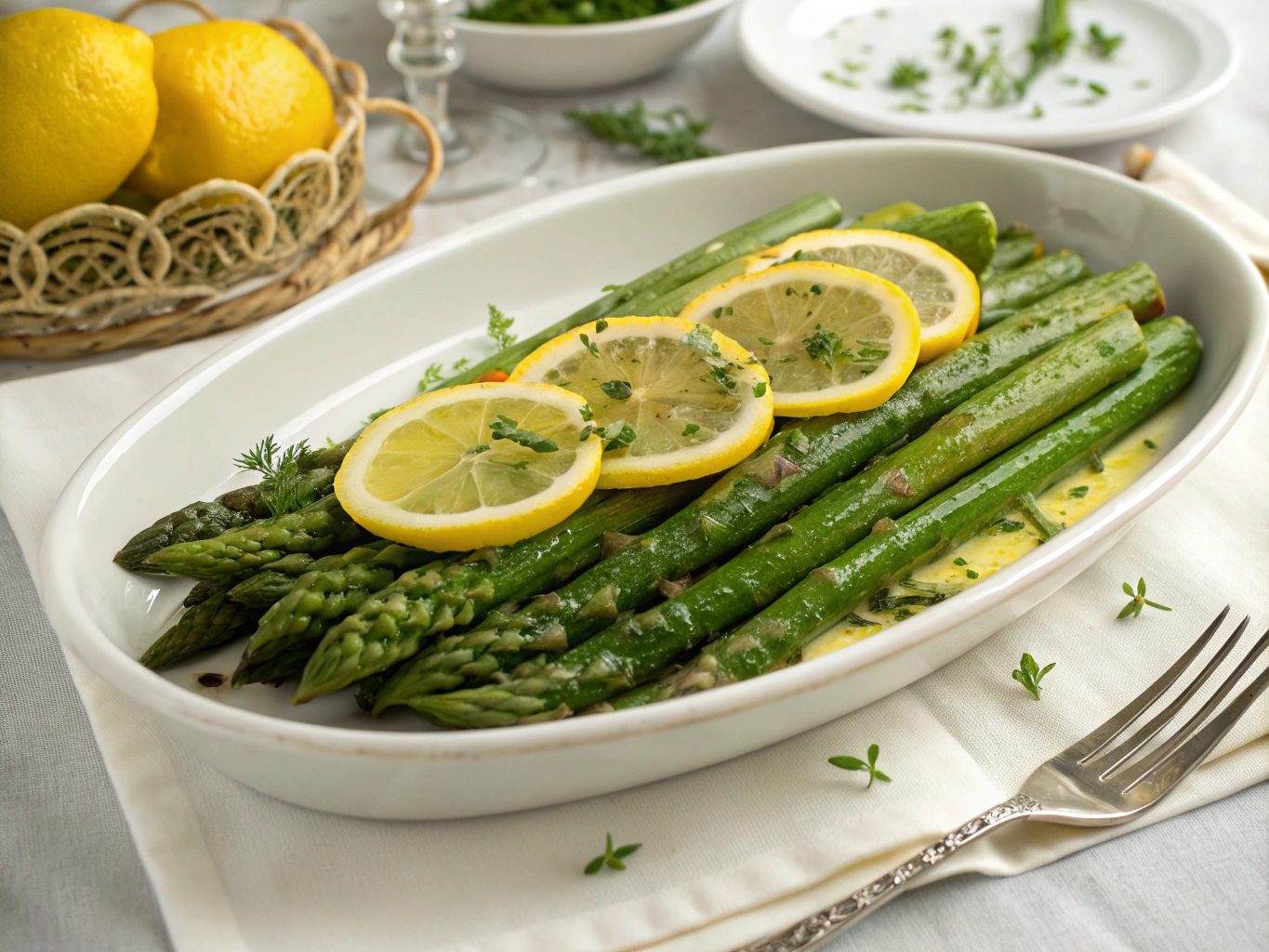
If freshness had a flavor, lemon asparagus would be it. This bright, zesty duo brings out the best in each other—and in pasta. In this article, we’re walking through my favorite spring-on-a-plate recipe: Lemon Asparagus Pasta. From its roots in my childhood kitchen in Charleston to the ingredient swaps and cooking shortcuts that make it weeknight-friendly, we’ll cover everything from flavors and nutrition to expert step-by-step instructions. We’ll also dive into variations, pro tips, and commonly asked questions to help you bring this energetic dish to life in your kitchen. Whether you’re new to asparagus or a seasoned pasta pro, you’ll find something to savor here.
A Craft Cook’s Tale: Why Lemon Asparagus Pasta Means More to Me Than a Meal
Memories of Picking and Cooking With Grandma
Growing up in Charleston, I learned early on that food wasn’t just about eating. It was about gathering, experimenting, and finding magic in humble ingredients. One spring afternoon, back when I was no more than nine, I remember helping my grandmother string fresh asparagus that we had picked from a neighbor’s yard. We didn’t own a steamer or mandoline—only good noses and better instincts. She’d finish the dish with a generous splash of lemon juice, and the moment that citrus hit the pan, her kitchen came alive like Sunday morning gospel.
That’s where my lemon asparagus pasta began. Not in a restaurant kitchen or glossy cookbook—but in a steamy, love-filled space where no rulebook applied, and curiosity reigned supreme.
Honoring Simplicity with Flavor
Decades later, I’ve carried those early lessons into every recipe I cook for FlavivoRecipes.com. Lemon asparagus isn’t just a spring fling—it’s a celebration of simplicity, and proof that bold flavor doesn’t need rare ingredients. This pasta became my go-to after a long shift on the food truck or during neighborhood potlucks where folks wanted something comforting yet curious. The lemon adds brightness to the tender crunch of asparagus, and whether you’re eating it warm or chilled, it hugs your taste buds like home.
You’ll find similar soul-satisfying comfort in creamy roasted garlic hummus or even our hearty lentil and veggie stew. Every dish begins with a story and ends with empty plates.
Set Your Ingredients & Know Your Timing
Ingredients List
This recipe is flexible by nature, but these are my tried-and-true staples:
- 12 oz fettuccine (or spaghetti, penne for bite-sized versions)
- 1 bunch fresh asparagus, trimmed and cut into 2-inch pieces
- 3 tablespoons olive oil
- 3 cloves garlic, thinly sliced
- Zest and juice of 1 large lemon
- 1/4 teaspoon crushed red pepper flakes
- Salt and ground black pepper to taste
- 1/3 cup grated Parmesan or nutritional yeast for vegan option
- Optional: 1/4 cup chopped fresh basil or parsley
Substitutions:
- Gluten-free pasta for dietary needs
- Swap in zucchini ribbons or peas for seasonal variation
- Vegan cheese or a dollop of cashew cream for richness
Timing Table
| Preparation Step | Time Required |
|---|---|
| Prep & chop ingredients | 10 minutes |
| Cook pasta & blanch asparagus | 12 minutes |
| Sauté & mix | 5 minutes |
| Total Time | 27 minutes |
That’s less than 30 minutes—quicker than takeout and 25% faster than most pasta dishes!
Instructions with Flavor & Finesse
- Bring a large pot of salted water to a boil. Add pasta and cook according to package directions. Reserve 1 cup of pasta water before draining.
- While pasta cooks, heat 2 tbsp olive oil in a skillet over medium heat.
- Add garlic slices and red pepper flakes. Sauté until fragrant—about 2 minutes. Don’t let the garlic brown!
- Toss in the asparagus with a pinch of salt and sauté until just tender but still vibrant. Remove from heat.
- Return drained pasta to pot. Stir in remaining olive oil, lemon juice, lemon zest, and a few tablespoons of reserved pasta water.
- Fold in the asparagus and sautéed garlic mixture. Toss everything gently over low heat until the sauce lightly clings.
- Melt in Parmesan or toss in nutritional yeast. Add more pasta water if it feels dry.
- Taste, adjust seasoning, and garnish with fresh herbs for a final pop of color.
Pasta’s not your only option: you can use this lemon asparagus blend as a risotto topping or to elevate plain quinoa too.
Beyond the Basics of Lemon Asparagus Pasta
Nutritional Highlights & Benefits
Aside from awakening your taste buds, lemon asparagus pasta delivers a solid nutrient punch. Asparagus is rich in vitamins A, C, and K and packed with folate. The zing from lemon provides a dose of vitamin C and helps support iron absorption from that whole grain pasta or leafy side salad.
According to the National Institutes of Health, adding vitamin C-rich foods like lemon enhances iron absorption—perfect if you’re pairing this dish with plant-based proteins.
This recipe also scores high on satiety with its quality fats (thanks, olive oil), fiber from the asparagus, and protein if topped with chickpeas or grilled tofu.
Make it Your Own: Flavor Upgrades
Want some extra umph? Add toasted pine nuts for crunch. Crave protein? Grilled shrimp, tempeh, or even a poached egg turn this into an anytime meal. Dial up the heat with extra red chili flakes or stir in capers for brininess.
You can also make it super creamy by stirring in roasted cauliflower cream sauce or ricotta at the end. For a bolder herbaceous note, try adding torn mint or tarragon.
This adaptable recipe also works as a meal prep winner. Simply store the mixed pasta in an airtight container and reheat with a splash of broth or lemon water.
Expand the Flavor Palette
Italian Origins with an American Twist
While traditional Italian cuisine incorporates asparagus—yes, Italians certainly do add asparagus to pasta dishes!—the bright pairing of lemon with pasta also hails from Southern Italian roots, especially in Sicily where lemons grow abundantly.
That said, my version is rooted in Southern American pragmatism, layered with bold experimentation.
Dishes like this one live at the crossroads of tradition and creativity, similar to how our Southern-style grits with mushrooms honor both place and play.
Crowd-Pleaser Tips for Hosting & Leftovers
Serving this at a dinner party? Finish with an herb drizzle or dollops of herbed goat cheese. Pair it with chilled white wine or lemony mocktails for a sparkling match. The dish also holds up phenomenally for picnics or meal prep. Chill and sprinkle with extra lemon zest before serving cold.
For picky eaters or kids, swap in smaller pasta shapes (like bowties), skip the red chili flakes, and maybe toss in a bit of cream cheese or butter during sautéing for extra comfort.
Lemon asparagus pasta is also a lovely side for Easter brunch or spring holidays. Its fresh look and cleaner flavor often ride well alongside fruit salads and baked veggies.
FAQ
Does lemon juice go with asparagus?
Absolutely—it’s a classic combo. The acidity of lemon juice brightens the earthy savor of asparagus and brings out sweet, grassy notes. It also helps retain asparagus’s vibrant green hue when lightly cooked.
What does adding lemon juice to pasta do?
Lemon juice boosts flavor, adding brightness and depth. It also slightly cuts through heavy fats or cheeses in pasta sauces, balancing the dish naturally with acidity.
What kind of pasta goes best with asparagus?
Long cuts like fettuccine or linguine coat beautifully with light lemony sauces. But short pastas—penne, orecchiette—work great too, especially when asparagus is chopped smaller. One advantage of short pasta: it’s easier for little hands or cold pasta salads.
Do Italians put asparagus in pasta?
Yes, especially during spring. In Italian kitchens, asparagus often appears in risottos, frittatas, and pastas with butter or cream sauces. My recipe leans into Italian technique with an American soul-food twist.
Conclusion
Lemon asparagus pasta is more than just another weeknight recipe—it’s a celebration of spring, flavor, and memory. With bright citrus, earthy asparagus, and comforting pasta, it bridges comfort and creativity with minimal effort and maximum satisfaction. Best of all, it’s endlessly flexible, friendly for beginner cooks, and fantastic hot or cold.
Whether you’re hosting brunch, prepping ahead for busy evenings, or recreating your own nostalgic kitchen aromas, this recipe brings heart, story, and nutrition to your table.
And if you’re just starting out on your plant-forward journey, don’t miss beginner-friendly guides like our chickpea tikka masala or quick mixed veggie stir-fry. There’s always room for one more bite of inspiration.
